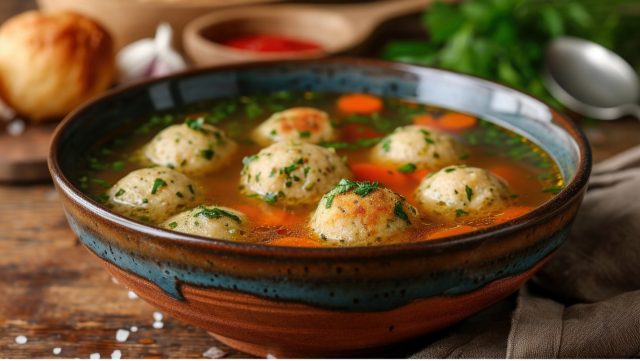Daniel Waxman of Long Island has spent many years tutoring Judaic studies. One thing students often find interesting is that Jewish culinary traditions offer a fascinating window into the rich tapestry of Jewish history and culture. Spanning continents and centuries, these food customs are not just about what is eaten, but also how, when, and why. In this post from Daniel Waxman, he will explore the diverse and flavorful world of Jewish cuisine, tracing its evolution and examining its significance in Jewish life.
Daniel Waxman on The Roots of Jewish Cuisine
Jewish cuisine is a rich tapestry of flavors and dishes that are deeply connected to the history and migration of Jewish people. Each dish has its own unique story to tell, reflecting the cultural influences and traditions of Jewish communities around the world.
One of the most significant aspects of Jewish cuisine is the adherence to kashrut, the Jewish dietary laws that govern food preparation and consumption. These laws are based on the biblical texts and are meant to ensure that food is prepared according to halacha, or Jewish law.
Kashrut dictates that certain foods are forbidden, including pork and shellfish. Meat and dairy products also cannot be mixed, and there are specific rules about how animals must be slaughtered and processed to ensure they are kosher.
Jewish cuisine is incredibly diverse, with different regions and communities putting their own unique spin on traditional dishes. Israeli cuisine, for example, is heavily influenced by Middle Eastern flavors and ingredients like za’atar, sumac, and tahini. Ashkenazi cuisine, on the other hand, is known for its hearty, comforting flavors and dishes like matzo ball soup, brisket, and latkes.
Daniel Waxman on Traditional Jewish Dishes
Ashkenazi Classics
- Challah: A sweet, braided bread typically enjoyed on the Sabbath and Jewish holidays. Its intricate braids symbolize love and unity.
- Gefilte Fish: A poached fish patty, traditionally made from a mixture of ground white fish, often served during Passover and other Jewish festivals.
- Matzo Ball Soup: A comforting soup featuring matzo balls (dumplings made from matzo meal) in chicken broth, a staple in many Jewish households.
Sephardic Delicacies
- Shakshuka: A spicy tomato and pepper stew with poached eggs, originating from North Africa and popular in Israel.
- Bourekas: Flaky pastries filled with cheese, potato, or spinach, reflecting the influence of Mediterranean and Balkan flavors.
Israeli Favorites
- Hummus and Falafel: Iconic Middle Eastern dishes that have become synonymous with Israeli street food.
- Sabich: A sandwich consisting of fried eggplant, hard-boiled egg, tahini, and salad, packed into a pita.
Daniel Waxman on The Role of Food in Jewish Holidays
Jewish holidays are often centered around specific foods, each with its own symbolism.
- Passover: Matzo, the unleavened bread, symbolizes the haste in which the Israelites left Egypt. Charoset, a sweet paste made of fruits and nuts, represents the mortar used by the Israelite slaves.
- Rosh Hashanah: Apples dipped in honey signify the hope for a sweet new year. Round challah represents the cyclical nature of life.
- Hanukkah: Foods fried in oil, like latkes (potato pancakes) and sufganiyot (jelly doughnuts), commemorate the miracle of the Temple oil.
Daniel Waxman of Long Island on The Influence of the Diaspora
The Jewish diaspora has led to an incredible diversity within Jewish cuisine. For example, Ethiopian Jews brought dishes like Doro Wat, a spicy chicken stew, into the Jewish culinary canon. Meanwhile, in the United States, Jewish delis popularized items like pastrami on rye and the bagel with lox and cream cheese.
Daniel Waxman on Modern Innovations
In recent times, Jewish cuisine has undergone a transformation with contemporary chefs and home cooks innovating within the bounds of tradition. While traditional Jewish dishes still hold their own, a new wave of fusion cuisine is on the rise, blending Jewish flavors with elements from other culinary cultures. This trend has gained immense popularity, and Jewish cuisine is increasingly being celebrated for its ability to blend cultures and flavors. Alongside fusion dishes, there is also a growing trend of vegetarian and vegan adaptations of classic Jewish dishes. This is a reflection of modern health and ethical considerations, and many Jewish chefs are now creating plant-based versions of classic dishes, making them more accessible and inclusive for all. Overall, Jewish cuisine is evolving, and it is exciting to see the fusion of traditional and modern elements in the kitchen.
Jewish cuisine is a vivid reflection of the Jewish people’s history, culture, and religion. It’s a cuisine that has evolved and adapted, absorbing influences from across the globe while retaining a unique identity tied to tradition and ritual. Whether it’s a comforting bowl of matzo ball soup or a festive holiday meal, Daniel Waxman explains these dishes carry the flavors of generations and the spirit of a rich, enduring culture.









